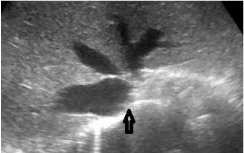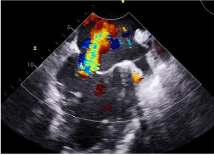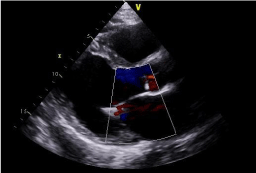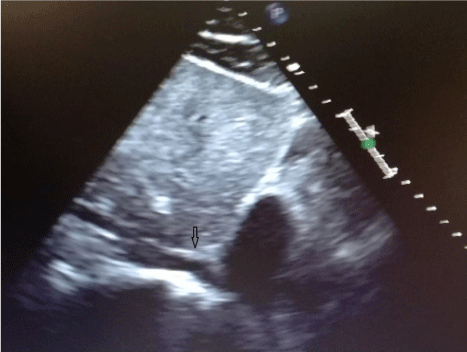
Special Article - Mitraclip
Austin J Vasc Med. 2016; 3(1): 1016.
Mitraclip Benefits in Right-Sided Heart Failure: A Case Report
Cardoso C¹*, Garcia T¹, Cachado P¹, Cacela D², Branco L² and Monteiro A²
¹Department of Internal Medicine, Central Lisbon Centre, Portugal
²Department of Cardiology, Central Lisbon Centre, Portugal
*Corresponding author: Catarina Cardoso, Department of Internal Medicine, Santa Marta Hospital, Central Lisbon Centre, Portugal
Received: June 06, 2016; Accepted: July 10, 2016; Published: July 11, 2016
Abstract
Congestive hepatopathy is a symptom of right-sided heart failure; significantly lowering quality of life and increasing hospital admissions.
Mitraclip has emerged as a treatment option in high surgical risk patients with severe mitral regurgitation and its associated symptoms such as dyspnea and fatigue. It is mainly indicated in degenerative valve disease, but functional regurgitation treatment is currently being evaluated in randomized trials.
We report a case of highly symptomatic congestive hepatopathy treated with severe mitral regurgitation reduction after Mitraclip implantation.
Keywords: Right heart failure; Congestive hepatopathy; Functional regurgitation; Mitraclip
Introduction
Mitraclip is currently used in symptomatic heart failure patients with severe mitral valve regurgitation unable to undergo surgical treatment [1]. Mitral valve regurgitation is an important cause of morbidity in heart failure due to its symptoms and patients perceive them differently [2]. Although dyspnea and fatigue are the most commonly reported, right heart failure complaints such as those related to liver congestion are not negligible [3,4] and therefore are also important to consider if our aim is to improve patient’s overall well being.
Functional mitral regurgitation is common in dilated cardiomyopathy and up to 50% of symptomatic heart failure patients with severe regurgitation are not treated due to the high risk surgical procedure [5]. The role of Mitraclip in this type of disorder has been evaluated on the following observational studies: EVEREST II, TRAMI, ACCESS-EU, MARS, European Sentinel, MitraSwiss, French multicentre registries, Treede et al., Bozdag-Turan et al., Rudolph et al., Braun et al., Neus et al., with improved clinical outcomes [6-17].
We report a case of a patient with ischemic dilated cardiomyopathy with biventricular dysfunction whose main symptoms were related to congestive hepatopathy unresponsive to pharmacological treatment. We were able to successfully manage this issue with Mitraclip implantation.
Case Presentation
A 65-year-old man with a past medical history of hypertension, stage three chronic kidney disease, permanent atrial fibrillation and ischemic dilated cardiomyopathy with New York Heart Association (NYHA) class 2 heart failure was hospitalized due to one-month history of worsening of bilateral leg edema, abdominal right upper quadrant discomfort with nausea (especially after meals), subsequent weight loss (11 pounds) and anorexia. He also reported dyspnea on mild exertion with no fatigue, but according to the patient those were not considered important complaints with limitation in daily life activities. He denied other gastrointestinal symptoms, fever, night sweats, cough, palpitations, chest and low back pain or even genitourinary symptoms.
On general examination, he had a body mass index of 18 kg/ m² and at rest he did not have dyspnea. He was anicteric, wellhydrated and demonstrated right internal jugular vein distention. Cardiopulmonary auscultation revealed a grade 5 systolic murmur at the apical area with axillary irradiation and discrete bilateral lung rales. Abdominal examination elicited pain during superficial palpation on the right upper quadrant with hepatomegaly identification, with no signs of ascites. He had significant symmetrical peripheral pitting edema without any signs of deep vein thrombosis. His vital signs were normal, including fever absence. There were no additional examination abnormalities.
Abdominal ultrasound showed signs of congestive hepatomegaly with a dilated inferior vena cava (Figure 1) and a diffuse gallbladder wall thickening with small ascites, without additional complications. Laboratory studies only showed a mild cytocholestatic pattern (alkaline phosphatase 167 IU/L; aminotransferase 76 IU/L; alaninetransferase 80 IU/L; total bilirrubin 2.0 mg/dL). Chest x-ray did not show additional changes besides those previously known such as cardiomegaly. Electrocardiogram showed atrial fibrillation with a normal heart rate. Brain natriuretic peptide was 690 ng/L.

Figure 1: Dilated inferior vena cava.
It was considered a clinical case of right heart failure whose main complaints were related to liver congestion.
He was later transferred to a medical ward where he began diuretic treatment but after one week his symptoms did not show any improvement, worsening whenever he ate with early satiety, recurrent right upper quadrant discomfort and bloating. He was not able to increase his dietary intake in order to gain weight and became depressed with this condition.
He underwent additional investigation with doppler abdominal ultrasound, abdominal and pelvic computed tomography scan and endoscopic studies which found no abnormalities.
A transesophageal echocardiography documented left dilated ventricle dysfunction (telessystolic diameter- 65 mm/m²) with the same low ejection fraction (21%), but with severe mitral regurgitation (Figure 2). It showed posterior leaflet retraction with an eccentric jet swirling in left atrium; Effective Regurgitant Orifice Area (EROA) - 0.4 cm², regurgitant volume - 46 mL. Bilateral atrial dilation was present (right atrium 42 mL/m²), non-dilated right ventricle dysfunction;

Figure 2: Transesophageal echocardiography showing severe functional
mitral regurgitation.
Tricuspid Annular Plane Systolic Excursion (TAPSE) - 11 mm; tricuspid annular systolic velocity - s’ 8 cm/sec with mild tricuspid regurgitation and moderate systolic pulmonary hypertension (50 mmHg).
His symptoms were attributed mainly to right heart failure due to left ventricle dysfunction with severe functional mitral regurgitation. He was considered a high-surgical risk patient and therefore this issue was discussed with interventional cardiology. Since the patient did not fulfill criteria for resynchronization therapy, he was considered for Mitraclip device after echocardiographic assessment to determine eligibility for this percutaneous approach.
Two Mitraclip were placed with demonstration of nonsignificant transmitral gradient of 1mmHg after the procedure. Mitral regurgitation improved from grade four to one (Figure 3) and it was documented a small interatrial communication. (10,4x22,6 mm).

Figure 3: Transthoracic echocardiography after mitraclip implantation
showing mild mitral regurgitation.
He was discharged with no registered complications during his hospital stay.
After one month no abdominal symptoms were present, he regained appetite with weight and mood improvement and was in NYHA class II. Transthoracic echocardiographic evaluation after one month showed no worsening on parameters such as mitral regurgitation which remained in grade one (EROA - 0,19 cm², regurgitant volume - 29 mL). Additional measurements showed small improvements such as right atrial volume reduction (31 mL/m²), TAPSE increase (14 mm), systolic pulmonar hypertension reduction (45 mmHg) and a non dilated inferior vena cava (Figures 4 & 5). Left ventricular function did not change significantly (29%).

Figure 4: Non-dilated inferior vena cava.

Figure 5: Inferior vena cava diameter variation with inspiration.
Discussion
This case highlights the importance of devices such as Mitraclip on less common and usually overlooked heart failure symptoms.
Congestive hepatopathy is frequently assymptomatic, but mild discomfort in the right upper abdominal quadrant with early satiety; nausea and anorexia are reported in some patients. Our patient experienced a significant burden when suffering from these symptoms, which usually improve with diuretic therapy. Untreated longstanding congestion can lead to cardiac fibrosis and ultimately cardiac cirrhosis [18]. Adequate nutrition and mainteinance of a normal body mass index is important in heart failure, because weight loss is one of its consequences. Catabolic processes and neurohormonal and immune activation are some of the factors involved, but diminished food intake due to early satiety caused by congestive hepatomegaly is an additional important mechanism whose treatment is mainly pharmacological systemic venous decongestion [19].
Dilated cardiomiopathy is frequently complicated by functional mitral regurgitation and although surgical treatment has been advocated to correct it, most of the patients have high-surgical risk with significant mortality rates, which limit adequate candidates.
Mitraclip’s current role on functional mitral regurgitation treatment, as opposed to degenerative mitral valve disease, remains unclear. Despite the lack of official recommendations, ongoing trials about this matter such as COAPT, RESHAPE-HF may help clarify the problem and eventually strengthen or add labeling claims regarding benefits of Mitraclip in this condition.
Conclusion
Life quality is currently one major desire in chronic heart failure patients. This is the first clinical case report demonstrating the successful role of Mitraclip in gastrointestinal symptoms related to chronic right heart failure.
References
- Magruder JT, Crawford TC, Grimm JC, Fredi JL, Shah AS. Managing mitral regurgitation: focus on the MitraClip device. Med Devices (Auckl). 2016; 9: 53-60.
- Kato M, Stevenson LW, Palardy M, Campbell PM, May CW, Lakdawala NK, et al. The Worst Symptom As Defined By Patients during Heart Failure Hospitalization: Implications for Response to Therapy. J Card Fail. 2012; 18: 524-533.
- Alvarez AM, Mukherjee D. Liver abnormalities in cardiac diseases and heart failure. Int J Angiol. 2011; 20: 135-142.
- Kavoliuniene A, Vaitiekiene A, Cesnaíte G. Congestive hepatopathy and hypoxic hepatitis in heart failure: a cardiologist’s point of view. Int J Cardiol. 2013; 166: 554-558.
- Mirabel M, Iung B, Baron G, Messika-Zeitoun D, Détaint D, Vanoverschelde JL, et al. What are the characteristics of patients with severe, symptomatic, mitral regurgitation who are denied surgery? Eur Heart J. 2007; 28: 1358-1365.
- Whitlow PL, Feldman T, Pedersen WR, Lim DS, Kipperman R, Smalling R, et al. EVEREST II Investigators. Acute and 12-month results with catheter based mitral valve leaflet repair: the EVEREST II (Endovascular Valve Edge-to-Edge Repair) high risk study. J Am Coll Cardiol. 2012; 59: 130-139.
- Baldus S, Schillinger W, Franzen O, Bekeredjian R, Sievert H, Schofer J, et al. German Transcatheter Mitral Valve Interventions (TRAMI) Investigators. MitraClip therapy in daily clinical practice: initial results from the German Transcatheter Mitral Valve Interventions (TRAMI) registry. Eur J Heart Fail. 2012; 14: 1050-1055.
- Maisano F, Franzen O, Baldus S, Schafer U, Hausleiter J, Butter C, et al. Percutaneous mitral valve interventions in the real world: early and one year results from the ACCESS-EU, a prospective, multicenter, non-randomized post-approval study of the MitraClip® therapy in Europe. J Am Coll Cardiol. 2013; 62: 1052-1061.
- Yeo KK, Yap J, Yamen E, Muda N, Tay E, Walters DL, et al. Percutaneous mitral valve repair with the MitraClip: early results from the MitraClip Asia-Pacific Registry (MARS). EuroIntervention. 2014; 10: 620-625.
- Nickenig G, Estevez-Loureiro R, Franzen O, Tamburino C, Vanderheyden M, Luscher TF, et al. Percutaneous mitral valve edge-to-edge repair: in-hospital results and 1-year follow-up of 628 patients of the 2011-2012 Pilot European Sentinel Registry. J Am Coll Cardiol. 2014; 64: 875-884.
- Surder D, Pedrazzini G, Gaemperli O, Biaggi P, Felix C, Rufibach K, et al. Predictors for efficacy of percutaneous mitral valve repair using the MitraClip system: the results of the MitraSwiss registry. Heart. 2013; 99: 1034-1040.
- Armoiry X, Brochet E, Lefevre T, Guerin P, Dumonteil N, Himbert D. Initial French experience of percutaneous mitral valve repair with the MitraClip: a multicentre national registry. Arch Cardiovasc Dis. 2013; 106: 287-294.
- Treede H, Schirmer J, Rudolph V, Franzen O, Knap M, Schluter M, et al. A heart team’s perspective on interventional mitral valve repair: percutaneous clip implantation as an important adjunct to a surgical mitral valve program for treatment of high-risk patients. J Thorac Cardiovasc Surg. 2012; 143: 78-84.
- Bozdag-Turan I, Paranskaya L, Birkemeyer R, Turan RG, Kische S, Akin I, et al. Percutaneous mitral repair with the MitraClip system in patients with mild-to-moderate and severe heart failure: a single centre experience. Cardiovasc Ther. 2014; 32: 66-73.
- Rudolph V, Knap M, Franzen O, Schluter M, de Vries T, Conradi L, et al. Echocardiographic and clinical outcomes of MitraClip therapy in patients not amenable to surgery. J Am Coll Cardiol. 2011; 58: 2190-2195.
- Braun D, Lesevic H, Orban M, Michalk F, Barthel P, Hoppe K. Percutaneous edge-to-edge repair of the mitral valve in patients with degenerative versus functional mitral valve regurgitation. Catheter Cardiovasc Interv. 2014; 84: 137-146.
- Neuss M, Schau T, Schoepp M, Seifert M, Holschermann F, Meyhofer J, et al. Patient selection criteria and midterm clinical outcome for MitraClip therapy in patients with severe mitral regurgitation and severe congestive heart failure. Eur J Heart Fail. 2013; 15: 786-795.
- Weisberg IS, Jacobson IM. Cardiovascular diseases and the liver. Clin Liver Dis. 2011; 15: 1-20.
- Okoshi MP, Romeiro FG, Paiva SA, Okoshi K. Heart Failure-Induced Cachexia. Arq Bras Cardiol. 2013; 100: 476-482.